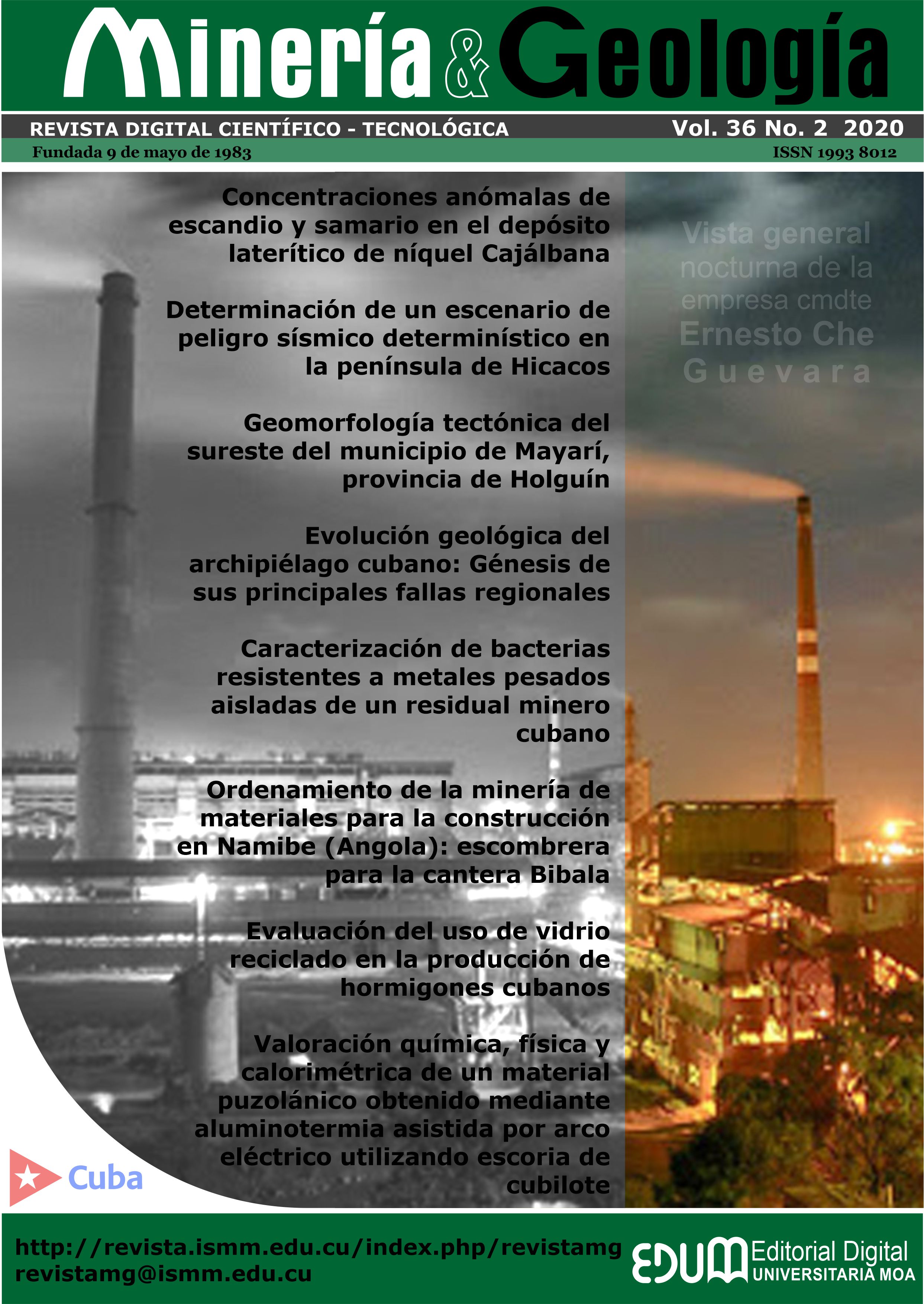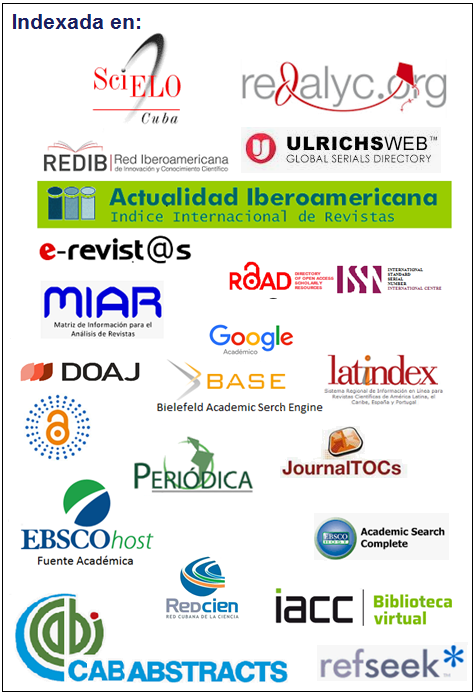Evaluating the use of recycled glass in Cuban concrete production
Keywords:
recycled ground glass, cement, concrete, sand, compressive strength.Abstract
With the purpose of using recycled glass in concrete mixtures as a partial substitute for sand and cement in Cuba, researches are carried out. This article shows the result at a laboratory scale in substituting fine aggregate and cement with ground glass in dosages of 25%, 50% and 100% for the first one and 10%, 20% and 30% for the second one. The mixtures obtained were compared to a standard for consistency and compressive strength. In the fresh mixes, a directly proportional increase in consistency was obtained with the percentage of replacement of the sand but it was different for cement, however all of them maintained a consistency suitable for use. Compressive strength gradually increased in an interval from 7 to 28 days of mixing’s age obtaining values exceeding the standard sample in M1, M4 and M5 samples. The results support at a laboratory scale, the feasibility of replacing 25% of the sand and up to 20% of cement with ground glass, without affecting the standard compressive strength (25-35 MPa) for traditional concrete.Downloads
References
Catalán, C. 2013: Estudio de la influencia del vidrio molido en hormigones grado H15, H20 y H30. Trabajo de diploma. Universidad Austral de Chile. Consulta: 14/11/2019. Disponible en: cybertesis.uach.cl/tesis/uach/2013/bmfcic357e/doc/bmfcic357e.pdf
Emam, E. y Al-Tersawy, S. 2012: Recycled glass as a partial replacement for the fine aggregate in self-compacting concrete. Construction and Building Materials, 35: 785-791. ISSN: 0950-0618.
Guerson, M. y Walhoff, T. 2017: Influencia del vidrio molido en la resistencia a la compresión del concreto y costos de fabricación, comparado con el concreto convencional, Barranca-2016. Trabajo de diploma. Universidad Nacional Santiago Antúnez de Mayolo. Perú.
Lam, C. y Poon, C. 2007: Enhancing the performance of pre-cast concrete blocks by incororating waste glass–ASR consideration. Cement & Concrete Composites, 29(8): 616–625. ISSN: 0958-9465.
Metwally, I. 2007: Investigations on the Performance of Concrete Made with Blended Finely Milled Waste Glass. Advances in Structural Engineering, 10(1): 47–53. ISSN: 1369-4332.
Nassar, R. U. D. y Soroushian, P. 2012a: Field investigation of concrete incorporating milled waste glass. USA: Michigan State University.
Nassar, R. U. D. y Soroushian, P. 2012b: Strength and durability of recycled aggregate concrete containing milled glass as partial replacement for cement. USA: Michigan State University.
Norma NC 251. 2013: Áridos para hormigones hidráulicos. Requisitos. La Habana: Oficina Nacional de Normalización.
Norma NC ISO 1920-2. 2010: Ensayos al hormigón –parte 2: propiedades del hormigón fresco. La Habana: Oficina Nacional de Normalización.
Norma NC ISO 1920-3. 2010: Ensayos al hormigón –parte 3: elaboración y curado de probetas para ensayos. La Habana: Oficina Nacional de Normalización.
Norma NC: 221. 2002: Hormigón. Elaboración de probetas para ensayos. La Habana: Oficina Nacional de Normalización.
Norma NC: 251. 2015: Áridos para hormigón. Especificaciones de Calidad. La Habana: Oficina Nacional de Normalización.
Norma NC: 95. 2017: Cemento Portland. Especificaciones. La Habana: Oficina Nacional de Normalización.
Peñafiel, D. 2016: Análisis de la resistencia a la compresión del hormigón al emplear vidrio reciclado molido en reemplazo parcial del agregado fino. Tesis de maestría. Universidad Técnica de Ambato. Consulta: 14/11/2019. Disponible en: http://repositorio.uta.edu.ec/jspui/handle/123456789/23038
Poveda, R.; Granja, V.; Hidalgo, D. y Avila, C. 2015: Análisis de la influencia del vidrio molido sobre la resistencia al desgaste de adoquines de hormigón tipo A. Revista Politécnica, 35(3): 61-71.
Ramos, W. 2015: Propuesta de reciclado óptimo de vidrio para su utilización en el sector de la construcción de la ciudad de Quito. Trabajo de diploma. Universidad de las Américas.
Rodríguez, M. y Ruiz, M. 2016: Evaluación del desempeño de un hormigón con incorporación de vidrio reciclado finamente molido en reemplazo de cemento mediante ensayos de laboratorio. Revista Facultad de Ciencias Exactas, Físicas y Naturales, 3(2): 53–60. ISSN: 2362–2539.
Sánchez, J. E. 2015: El reciclaje de los envases de vidrio en Cuba. Revista Caribeña de Ciencias Sociales. Consulta: 14/11/2019. Disponible en: http://www.eumed.net/rev/caribe/2015/09/vidrio.html
Soroushian, P. 2012: Towards broad use of recycled glass concrete on must campus. USA: Michigan State University.
Terro, M. 2005: Properties of concrete made with recycled crushed glass at elevated temperatures. Building and Environment, 41(5): 633–639. ISSN: 0360-1323.
Published
How to Cite
Issue
Section
Copyright (c) 2020 Lianis de los Ángeles Columbié Lamorú

This work is licensed under a Creative Commons Attribution-NonCommercial 4.0 International License.
- Authors retain copyright and guaranteeing the right magazine to be the first publication of the work as licensed under a Creative Commons Attribution-NonCommercial that allows others to share the work with an acknowledgment of the work's authorship and initial publication in this journal.
- Authors may establish separate supplemental agreements for the exclusive distribution version of the work published in the journal (eg, place it in an institutional repository or publish it in a book), with an acknowledgment of its initial publication in this journal.
- Authors are allowed and recommended to disseminate their work through the Internet (e.g., in institutional telematic archives or on their websites) before and during the submission process, which can produce interesting exchanges and increase citations of the published work. (See The effect of open access)




